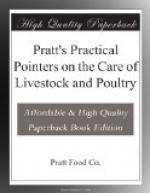-----
If cholera breaks out in the neighborhood the farmer should maintain a strict quarantine against the infected herds. He should refrain from visits to farms where they are located, and should insist on requiring that his neighbors stay out of his hog lots. Visiting of all kinds at this time should be carefully restricted. Dogs, cats, crows, and buzzards are very active carriers of infection from farm to farm, and should be guarded against as far as possible.
[Illustration: PRATTS PRACTICAL POINTERS]
COMMON DISEASES OF SWINE
(Symptoms and Treatment)
Diarrhoea or Scours
Cause.—By milk of the dam being affected by feeding of food tainted with the elements of decay; by making a sudden change in the food; by some disordered condition in the health of the sow, and by excess of milk furnished by the dam.
Usually occurs before the weaning stage, as a rule in swine not yet ten days old.
Symptoms.—Very soft condition of the voidings which are sometimes almost watery.
Treatment.—Being highly contagious, spray the floor thoroughly with Pratts Disinfectant. Keep the young swine comfortable and remove the voidings carefully two or three times a day. Correct the food given the dam, mixing Pratts Hog Tonic with her feed. Also give a small tablespoonful of sulphur daily to the sow.
Hog Cholera and Swine Plague
Hog Cholera and Swine Plague are very much alike. Both are characterized by inflammation of stomach and intestines, enlarged and inflamed lymphatic glands and sloughing of portions of the skin. The treatment and preventive measures are alike in many respects.
They are germ diseases, contracted in purchasing swine which may contract the germs when in transit on cars; by exhibiting at fairs; through persons who have visited infected herds; through the feet of dogs and birds to which the germs may have adhered; through the water of an infected pond or stream.
The most dangerous source of infection by far is coming in touch with diseased animals.
Reduced stamina and filthy quarters favor the spread of these diseases.
Hog Cholera
Symptoms.—Dullness, loss of appetite or depraved appetite and a disposition to lie down; constipation or diarrhoea; stiff gait; red spots or blotches discernible about the ears and under the neck and belly; in some instances there is difficulty in breathing.
Treatment.—Authorities agree that there is no known cure for real hog cholera. Preventive measures, therefore, are of vital importance. Pratts Disinfectant should be used frequently and to build up the general health of the hog, giving it full disease-resisting power, Pratts Hog Tonic should be added to the ration. Besides, it is a valuable tonic and fattener.




